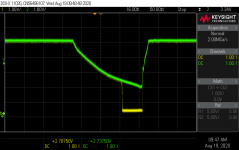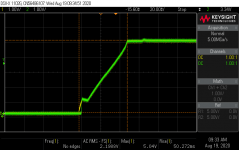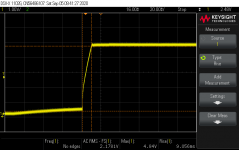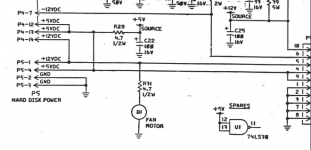ttb
Well-known member
I am trying to get a Daystar Turbo 040 working in my SE/30 using one of @Bolle's short adapters. I've already managed to work through other issues, but this one has me stumped. Basically, the machine will not find any startup disks when it boots from a cold start (e.g. flipping the power switch after it's been off for a second or more). I have tested this with two different working SE/30 logic boards, two different AB/PSUs, and two different SCSI2SDs. Also tried a different accelerator adapter, different floppy and SCSI cables, tried it with six different sets of RAM in different arrangements, swapping ROMs, etc.
The test matrix is basically accelerator installed vs not installed on one axis, floppy vs SCSI2SD on the other:
The boot floppy has a System 6.0.8 system folder on it. The SCSI2SD has a 7.5.5 system folder. The Turbo 040 has firmware 4.11. The SE/30 has the stock ROM. Notes about each configuration:
1) Works fine, no issues.
2) Works fine, no issues.
3) The system shows a gray screen with cursor. After a little bit, it shows the Turbo 040 happy mac briefly before ejecting the floppy. It then goes to a gray screen with no cursor an stays there. If I reinsert the floppy and press the reset button, the same thing happens. If I reinsert the floppy and blip the power switch (turn it off for less than a second), the same thing happens. Basically there is no way to get it to boot from the floppy.
View attachment IMG_1448.mp4
4) This would be the normal operating configuration (accelerator installed, boot from SCSI2SD). From a cold start it goes straight to a blinking question mark. The amount of time it takes to show the blinking question mark can vary a bit. It can be almost instant like below, or take several seconds. If I insert the boot floppy while the question mark is there, it goes into the same state described in note 3 above. If I hit the reset button, it will just give the blinking question mark again.
View attachment IMG_1449.mp4
The real weirdness (and hopefully a clue as to what's wrong) happens when I blip the power switch. This means interrupting power for less than a second (I haven't tried to find the lower bound, yet). When I do this, the system boots up without any hesitation. Additionally, once it is booted up, I can restart it at will and it remains fine. Hitting the reset switch also reboots it without issue.
View attachment IMG_1450.mp4
My initial thought was that the PSU is overloaded. I've only scoped the 5V line but did not see any sag on startup. I have not checked the other rails and I'm not sure whether the Turbo 040 would even use them. My other thought (before I did a lot of testing with the boot floppy) was that it was related to some setting in the SCSI2SD. I tried adding delay, different modes, etc but it always produced the same results.
Any thoughts on where I should start? I've basically done all of the component swapping I can think of to narrow it down. I'm hoping someone with a better idea of what the boot process entails and how the Turbo 040 integrates with that might be able to point me in a direction. Thanks!
The test matrix is basically accelerator installed vs not installed on one axis, floppy vs SCSI2SD on the other:
Code:
Floppy SCSI2SD
Not installed (1) (2)
Installed (3) (4)The boot floppy has a System 6.0.8 system folder on it. The SCSI2SD has a 7.5.5 system folder. The Turbo 040 has firmware 4.11. The SE/30 has the stock ROM. Notes about each configuration:
1) Works fine, no issues.
2) Works fine, no issues.
3) The system shows a gray screen with cursor. After a little bit, it shows the Turbo 040 happy mac briefly before ejecting the floppy. It then goes to a gray screen with no cursor an stays there. If I reinsert the floppy and press the reset button, the same thing happens. If I reinsert the floppy and blip the power switch (turn it off for less than a second), the same thing happens. Basically there is no way to get it to boot from the floppy.
View attachment IMG_1448.mp4
4) This would be the normal operating configuration (accelerator installed, boot from SCSI2SD). From a cold start it goes straight to a blinking question mark. The amount of time it takes to show the blinking question mark can vary a bit. It can be almost instant like below, or take several seconds. If I insert the boot floppy while the question mark is there, it goes into the same state described in note 3 above. If I hit the reset button, it will just give the blinking question mark again.
View attachment IMG_1449.mp4
The real weirdness (and hopefully a clue as to what's wrong) happens when I blip the power switch. This means interrupting power for less than a second (I haven't tried to find the lower bound, yet). When I do this, the system boots up without any hesitation. Additionally, once it is booted up, I can restart it at will and it remains fine. Hitting the reset switch also reboots it without issue.
View attachment IMG_1450.mp4
My initial thought was that the PSU is overloaded. I've only scoped the 5V line but did not see any sag on startup. I have not checked the other rails and I'm not sure whether the Turbo 040 would even use them. My other thought (before I did a lot of testing with the boot floppy) was that it was related to some setting in the SCSI2SD. I tried adding delay, different modes, etc but it always produced the same results.
Any thoughts on where I should start? I've basically done all of the component swapping I can think of to narrow it down. I'm hoping someone with a better idea of what the boot process entails and how the Turbo 040 integrates with that might be able to point me in a direction. Thanks!





